
Cirkit Designer
Your all-in-one circuit design IDE
Home /
Component Documentation
How to Use TDS SENSOR: Examples, Pinouts, and Specs
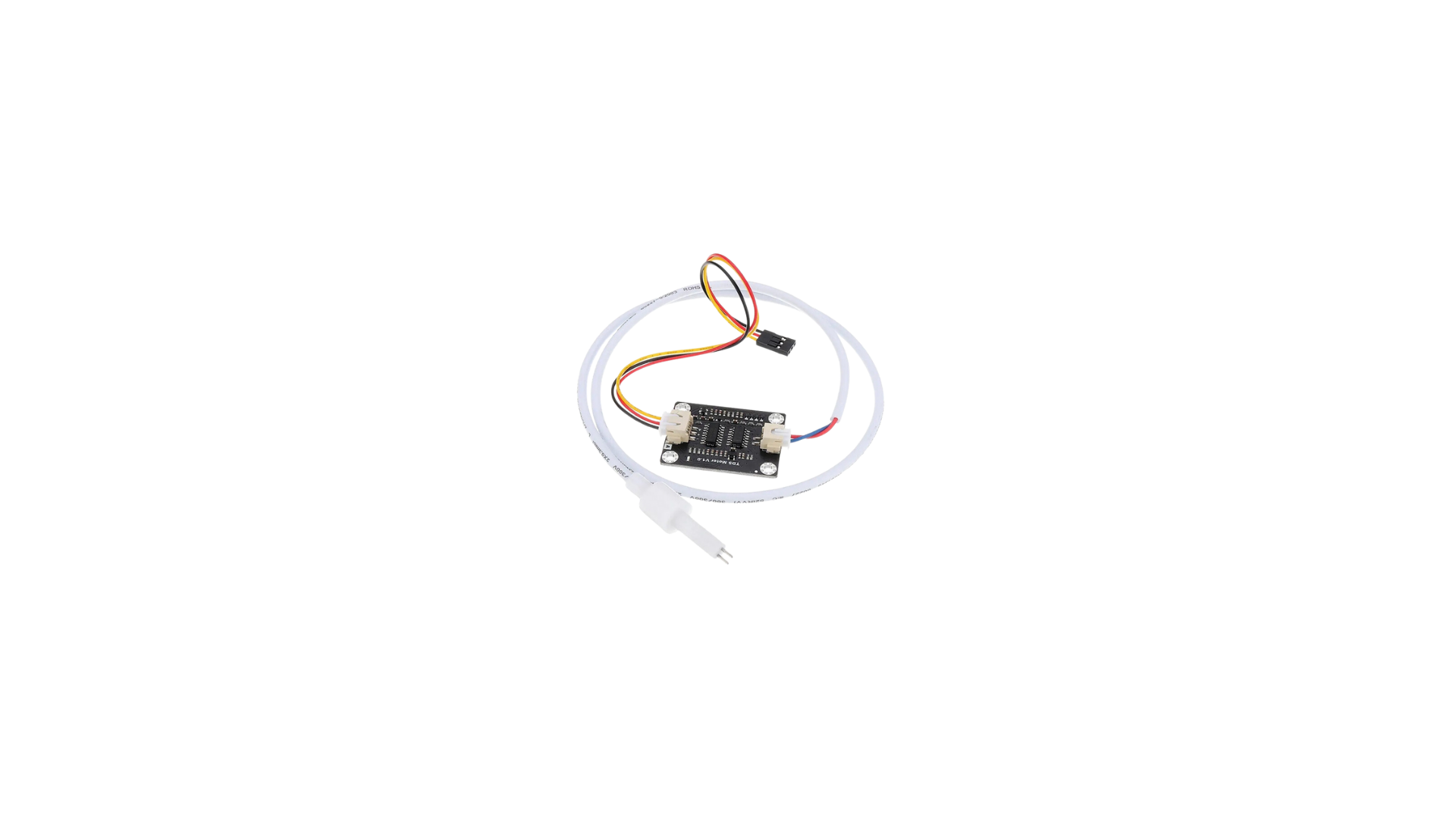
 Design with TDS SENSOR in Cirkit Designer
Design with TDS SENSOR in Cirkit DesignerIntroduction
- A TDS (Total Dissolved Solids) sensor measures the concentration of dissolved solids in a liquid, typically water. It provides an indication of water purity and quality by detecting ions, salts, and other dissolved substances.
- Common applications include water quality monitoring, aquariums, hydroponics, and industrial water treatment systems.
Explore Projects Built with TDS SENSOR
ESP32-Based Environmental Monitoring System with Wi-Fi Connectivity
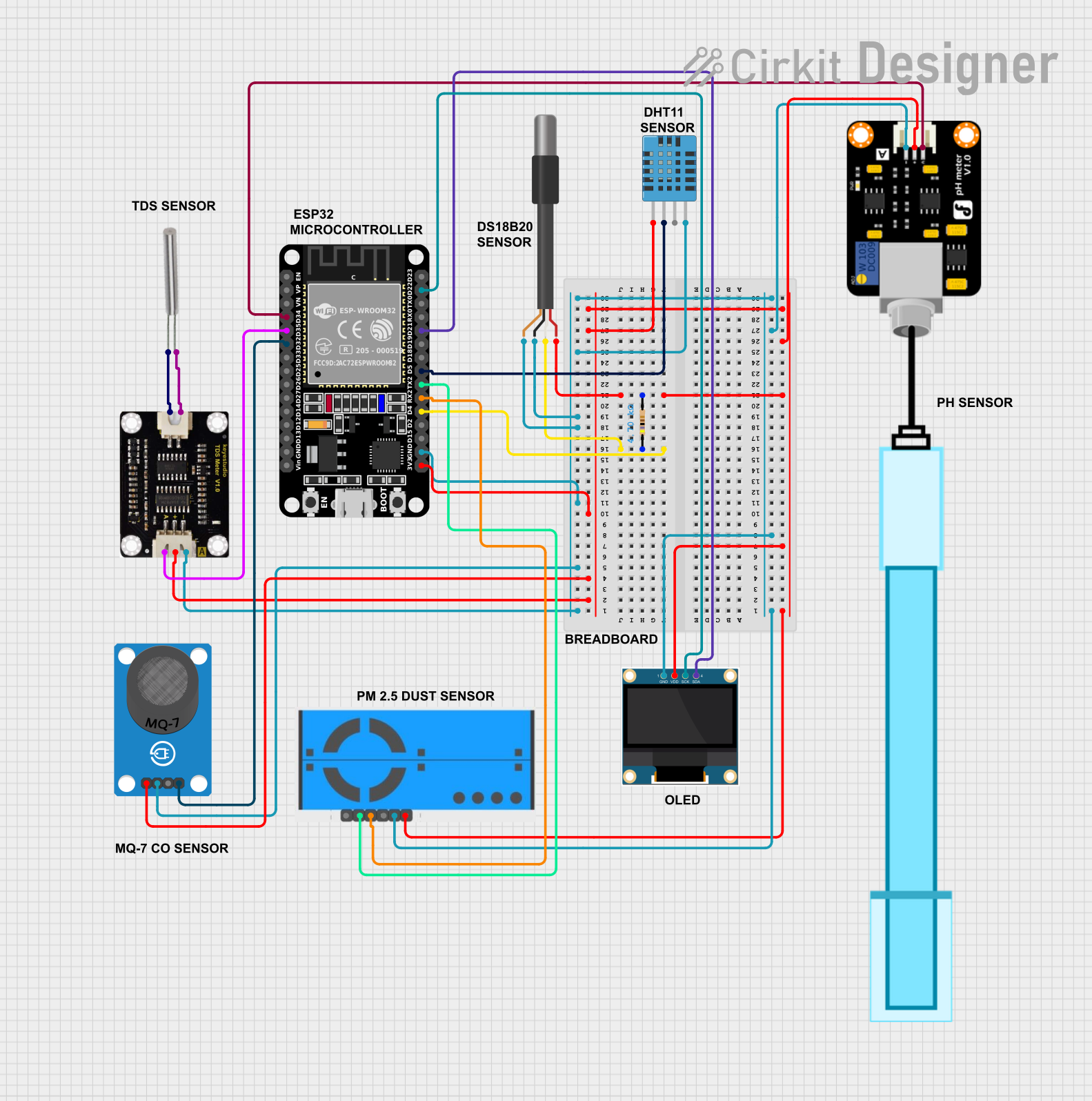
This circuit is an environmental monitoring system using an ESP32 microcontroller to collect data from various sensors, including temperature, humidity, air quality, pH, and TDS sensors. The collected data is displayed on an OLED screen, sent to ThingSpeak for remote monitoring, and email alerts are sent if critical thresholds are exceeded.
 Open Project in Cirkit Designer
Open Project in Cirkit DesignerESP32-Based TDS Meter for Water Quality Monitoring
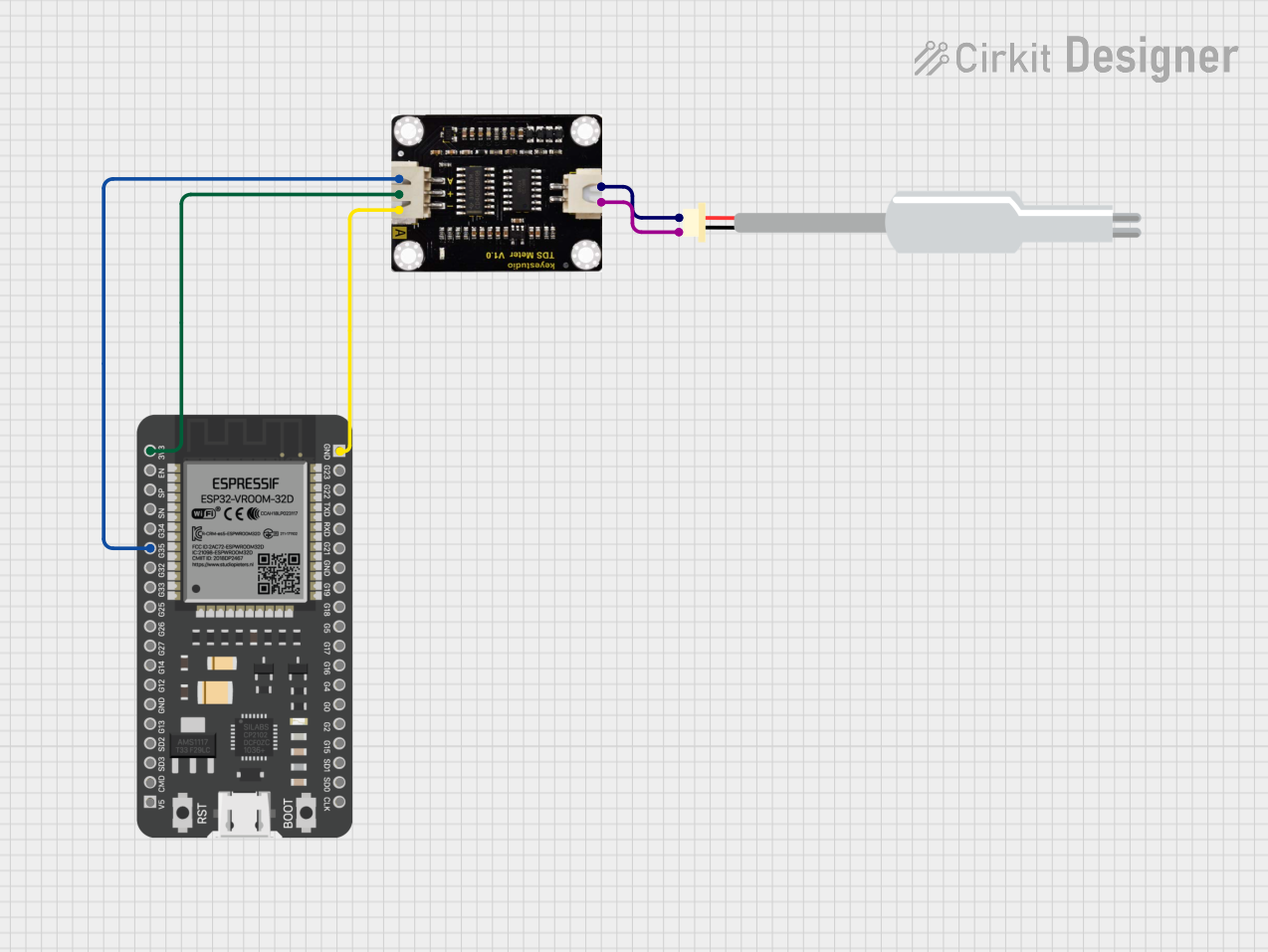
This circuit connects a TDS (Total Dissolved Solids) sensor to an ESP32 microcontroller. The TDS sensor's power is supplied by the ESP32's 3.3V and ground pins, and its analog output is connected to GPIO 35 of the ESP32 for measurement. The purpose of this circuit is to enable the ESP32 to read the TDS level of a solution, which is commonly used in water quality testing.
 Open Project in Cirkit Designer
Open Project in Cirkit DesignerArduino Leonardo-Based pH and TDS Sensor with OLED Display
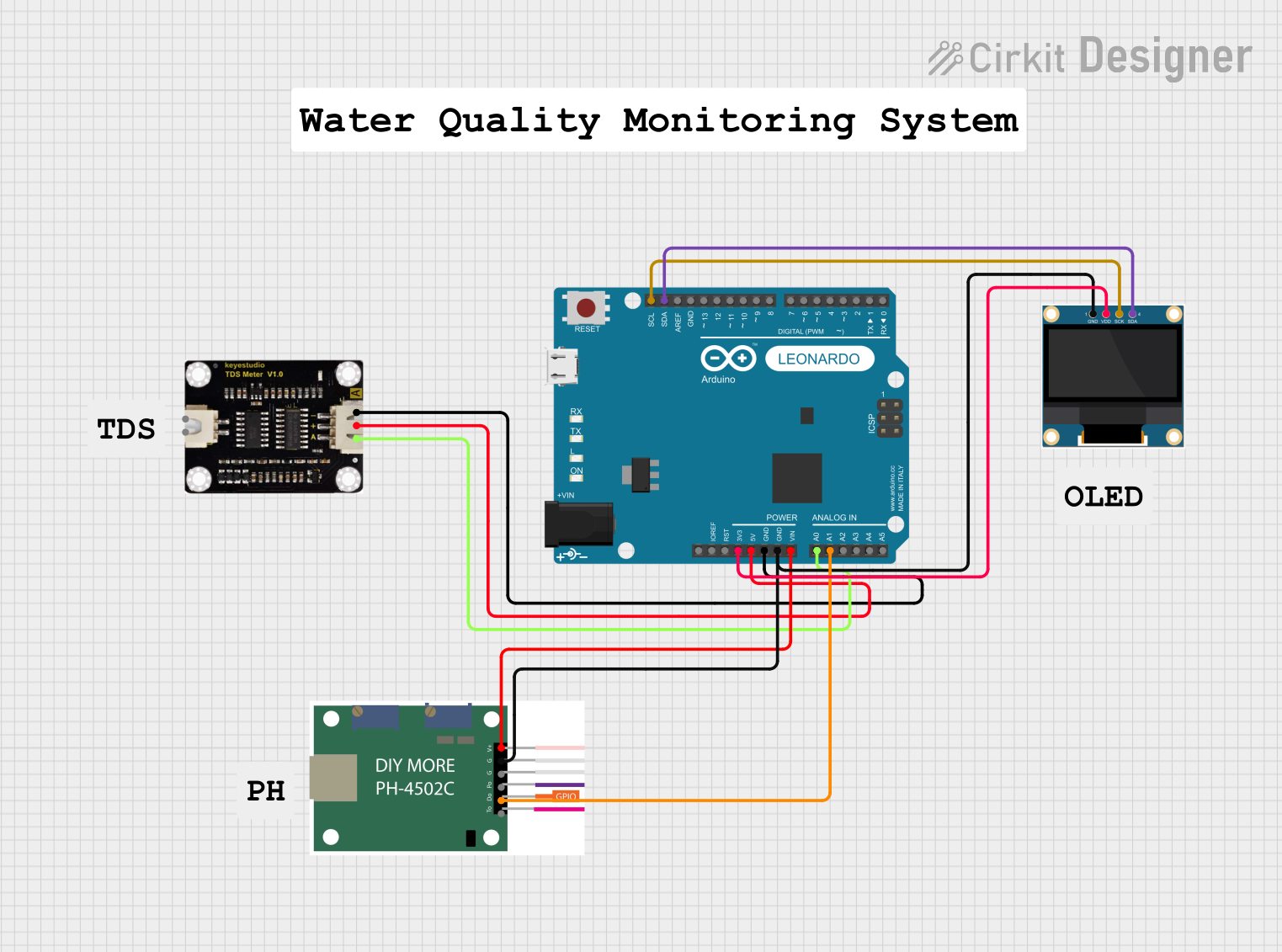
This circuit is designed to measure pH and TDS (Total Dissolved Solids) levels in a solution using a pH sensor and a TDS sensor, respectively, interfaced with an Arduino Leonardo. The measured data is then displayed on a 0.96" OLED screen.
 Open Project in Cirkit Designer
Open Project in Cirkit DesignerArduino UNO-Based Water Quality Monitoring System with TDS Sensor and SIM900A SMS Alerts
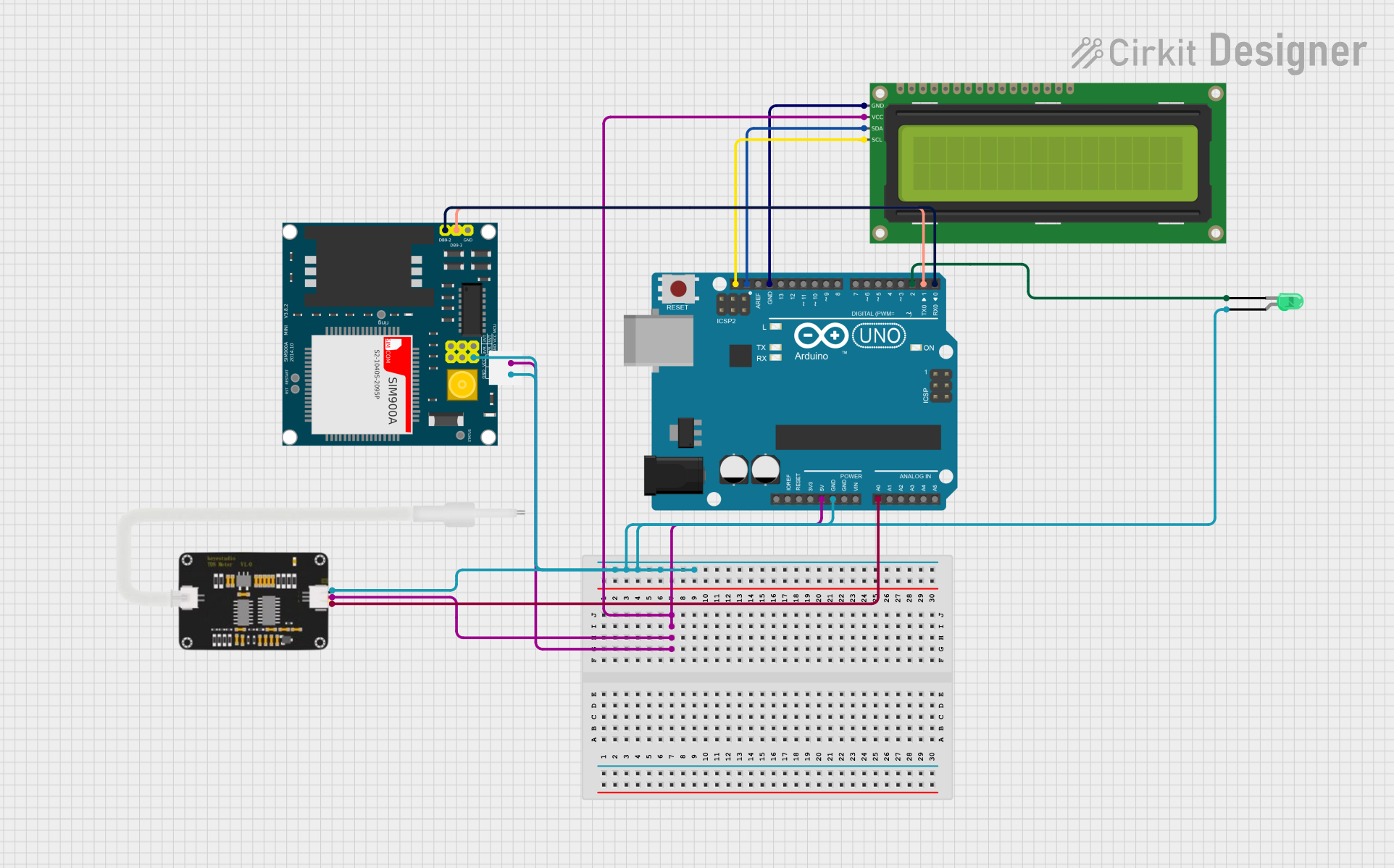
This circuit is a water quality monitoring system using an Arduino Uno, which reads TDS values from a TDS sensor and displays the results on a 16x2 I2C LCD. A green LED indicates good water quality, while a SIM900A module sends an SMS alert if the water quality is poor.
 Open Project in Cirkit Designer
Open Project in Cirkit DesignerExplore Projects Built with TDS SENSOR

ESP32-Based Environmental Monitoring System with Wi-Fi Connectivity
This circuit is an environmental monitoring system using an ESP32 microcontroller to collect data from various sensors, including temperature, humidity, air quality, pH, and TDS sensors. The collected data is displayed on an OLED screen, sent to ThingSpeak for remote monitoring, and email alerts are sent if critical thresholds are exceeded.
 Open Project in Cirkit Designer
Open Project in Cirkit Designer
ESP32-Based TDS Meter for Water Quality Monitoring
This circuit connects a TDS (Total Dissolved Solids) sensor to an ESP32 microcontroller. The TDS sensor's power is supplied by the ESP32's 3.3V and ground pins, and its analog output is connected to GPIO 35 of the ESP32 for measurement. The purpose of this circuit is to enable the ESP32 to read the TDS level of a solution, which is commonly used in water quality testing.
 Open Project in Cirkit Designer
Open Project in Cirkit Designer
Arduino Leonardo-Based pH and TDS Sensor with OLED Display
This circuit is designed to measure pH and TDS (Total Dissolved Solids) levels in a solution using a pH sensor and a TDS sensor, respectively, interfaced with an Arduino Leonardo. The measured data is then displayed on a 0.96" OLED screen.
 Open Project in Cirkit Designer
Open Project in Cirkit Designer
Arduino UNO-Based Water Quality Monitoring System with TDS Sensor and SIM900A SMS Alerts
This circuit is a water quality monitoring system using an Arduino Uno, which reads TDS values from a TDS sensor and displays the results on a 16x2 I2C LCD. A green LED indicates good water quality, while a SIM900A module sends an SMS alert if the water quality is poor.
 Open Project in Cirkit Designer
Open Project in Cirkit DesignerTechnical Specifications
- Input Voltage: 3.3V - 5.0V DC
- Output Voltage: 0 - 2.3V DC (analog signal)
- Measurement Range: 0 - 1000 ppm (parts per million)
- Accuracy: ±10% (at 25°C)
- Temperature Range: 0°C - 60°C
- Interface: Analog output
- Probe Material: Stainless steel (corrosion-resistant)
- Cable Length: Typically 1 meter
Pin Configuration and Descriptions
| Pin Name | Description |
|---|---|
| VCC | Power supply input (3.3V - 5.0V DC) |
| GND | Ground connection |
| AOUT | Analog output signal |
Usage Instructions
How to Use the TDS Sensor in a Circuit
Connect the Sensor:
- Connect the
VCCpin to a 3.3V or 5.0V power source. - Connect the
GNDpin to the ground of the circuit. - Connect the
AOUTpin to an analog input pin of a microcontroller (e.g., Arduino UNO).
- Connect the
Calibrate the Sensor:
- Use a known TDS solution (e.g., 342 ppm calibration solution) to calibrate the sensor.
- Adjust the calibration potentiometer on the sensor module until the output matches the known TDS value.
Place the Probe:
- Submerge the stainless steel probe in the liquid to be tested. Ensure the probe is fully immersed but avoid submerging the entire module.
Read the Output:
- The sensor outputs an analog voltage proportional to the TDS value. Use an ADC (Analog-to-Digital Converter) to read the signal.
Important Considerations and Best Practices
- Avoid Air Bubbles: Ensure no air bubbles are trapped around the probe, as this can affect accuracy.
- Temperature Compensation: TDS readings are temperature-dependent. Use a temperature sensor for compensation if precise measurements are required.
- Cleaning: Clean the probe regularly with distilled water to prevent residue buildup.
- Avoid Corrosion: Do not use the sensor in highly corrosive liquids or at temperatures beyond its specified range.
Example Code for Arduino UNO
// TDS Sensor Example Code for Arduino UNO
// Reads the analog output of the TDS sensor and converts it to ppm
const int TDS_PIN = A0; // Analog pin connected to the TDS sensor
float voltage, tdsValue;
void setup() {
Serial.begin(9600); // Initialize serial communication
pinMode(TDS_PIN, INPUT); // Set TDS pin as input
}
void loop() {
int sensorValue = analogRead(TDS_PIN); // Read analog value from sensor
voltage = sensorValue * (5.0 / 1023.0); // Convert to voltage (5V reference)
// Convert voltage to TDS value (ppm)
tdsValue = (voltage * 1000) / 2.3; // Assuming 2.3V corresponds to 1000 ppm
// Print the TDS value to the Serial Monitor
Serial.print("TDS Value: ");
Serial.print(tdsValue);
Serial.println(" ppm");
delay(1000); // Wait 1 second before next reading
}
Troubleshooting and FAQs
Common Issues and Solutions
No Output or Incorrect Readings:
- Solution: Check the wiring and ensure the sensor is powered correctly. Verify the probe is fully submerged in the liquid.
Fluctuating Readings:
- Solution: Ensure the liquid is still and free of air bubbles. Use a stable power supply to avoid noise.
Corrosion or Residue on the Probe:
- Solution: Clean the probe with distilled water and a soft cloth. Avoid using abrasive materials.
Inconsistent Calibration:
- Solution: Use a fresh calibration solution and ensure the potentiometer is adjusted carefully.
FAQs
Can the TDS sensor measure salinity?
Yes, TDS sensors can indirectly measure salinity, as dissolved salts contribute to the TDS value.Is the sensor waterproof?
Only the probe is waterproof. The module should not be exposed to water.Can I use the sensor for hot liquids?
No, the sensor is designed for liquids within the 0°C - 60°C range. Exceeding this range may damage the probe.How often should I calibrate the sensor?
Calibration frequency depends on usage. For critical applications, calibrate before each use. For general use, calibrate monthly.